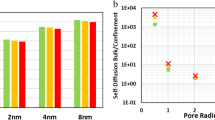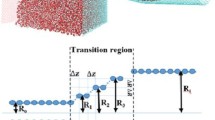Abstract
Molecular dynamics simulation is used to study flow rate behavior of monoatomic fluid through carbon nanotube (CNT) against the pore diameter. All armchair and zigzag CNTs with diameters below 1.5 nm were considered. Fluid flow rate versus diameter is investigated, and discrepancy was observed in the results. Its non-monotonic behavior is reported and attributed to diameter-dependent potential energy landscape in CNT. Effects of CNT length and pressure difference on flow rate as well as radial distribution function were examined as an additional check to ensure that the physical behavior of the model is correct. The deviation of fluid atoms from the minimum point in potential function is found to be significantly effective on the fluid–solid friction force experienced by fluid atoms, and consequently on the flow rate values. Also, investigating short periods of time shows that fluid atoms move discontinuously in the course of their passage through CNT. Consequently, distribution of atoms shows certain dense spots, similar to peaks in radial distribution which is well known and examined in the previous literature. Extremely low flow rate in some cases of CNT diameter and chirality shows that care should be taken in designing novel nanoscale devices which are built based on fluid flow and its properties in CNTs.










Similar content being viewed by others
References
Lee, J., Jeong, S., Liu, Z.: Progress and challenges of carbon nanotube membrane in water treatment. Crit. Rev. Environ. Sci. Technol. 46, 999–1046 (2016). https://doi.org/10.1080/10643389.2016.1191894
Ma, L., Dong, X., Chen, M., et al.: Fabrication and water treatment application of carbon nanotubes (CNTs)-based composite membranes: a review. Membranes (Basel) (2017). https://doi.org/10.3390/membranes7010016
Cao, B.Y., Sun, J., Chen, M., Guo, Z.Y.: Molecular momentum transport at fluid-solid interfaces in MEMS/NEMS: a review. Int. J. Mol. Sci. 10, 4638–4706 (2009). https://doi.org/10.3390/ijms10114638
Bianco, A., Kostarelos, K., Prato, M.: Applications of carbon nanotubes in drug delivery. Curr. Opin. Chem. Biol. 9, 674–679 (2005)
Nayak, A.K.: An analysis of steady/unsteady electroosmotic flows through charged cylindrical nano-channels. Theor. Comput. Fluid Dyn. 27, 885–902 (2013). https://doi.org/10.1007/s00162-013-0295-0
Majumder, M., Chopra, N., Hinds, B.J.: Mass transport through carbon nanotube membranes in three different regimes: ionic diffusion and gas and liquid flow. ACS Nano 5, 3867–3877 (2011). https://doi.org/10.1021/nn200222g
Cannon, J., Hess, O.: Fundamental dynamics of flow through carbon nanotube membranes. Microfluid Nanofluid. 8, 21–31 (2010). https://doi.org/10.1007/s10404-009-0446-1
Ahmed, S.B., Zhao, Y., Fang, C., Su, J.: Transport of a simple liquid through carbon nanotubes: Role of nanotube size. Phys. Lett. Sect. A Gen. At. Solid State Phys. 381, 3487–3492 (2017). https://doi.org/10.1016/j.physleta.2017.09.003
Su, J., Yang, K., Huang, D.: Ultra-fast single-file transport of a simple liquid beyond the collective behavior zone. Phys. Chem. Chem. Phys. 18, 20251–20255 (2016). https://doi.org/10.1039/c5cp07253k
Sun, C., Lu, W.Q., Bai, B., Liu, J.: Transport properties of Ar-Kr binary mixture in nanochannel Poiseuille flow. Int. J. Heat Mass Transf. 55, 1732–1740 (2012). https://doi.org/10.1016/j.ijheatmasstransfer.2011.11.028
Derakhshan, S., Rezaee, M., Sarrafha, H.: A molecular dynamics study of description models for shear viscosity in nanochannels: mixtures and effect of temperature. Nanoscale Microscale Thermophys. Eng. 19, 206–220 (2015). https://doi.org/10.1080/15567265.2015.1065527
Nicholls, W.D., Borg, M.K., Reese, J.M.: Molecular dynamics simulations of liquid flow in and around carbon nanotubes, in ASME 2010 8th International Conference on Nanochannels, Microchannels, and Minichannels Collocated with 3rd Joint US-European Fluids Engineering Summer Meeting, ICNMM2010. ASMEDC, pp. 979–985 (2010)
Huang, C., Nandakumar, K., Choi, P.Y.K., Kostiuk, L.W.: Molecular dynamics simulation of a pressure-driven liquid transport process in a cylindrical nanopore using two self-adjusting plates. J. Chem. Phys. 124, 234701 (2006). https://doi.org/10.1063/1.2209236
Huang, C., Choi, P.Y.K., Nandakumar, K., Kostiuk, L.W.: Investigation of entrance and exit effects on liquid transport through a cylindrical nanopore. Phys. Chem. Chem. Phys. 10, 186–192 (2008). https://doi.org/10.1039/B709575A
Yang, Y., Yang, X., Liang, L., et al.: Large-area graphene-nanomesh/ carbon-nanotube hybrid membranes for ionic and molecular nanofiltration. Science 80(364), 1057–1062 (2019). https://doi.org/10.1126/science.aau5321
Han, E.D., Kim, B.H., Seo, Y.H.: Experimental verification of Poiseuille flow in nanochannels. Jpn. J. Appl. Phys. 58, 065001 (2019). https://doi.org/10.7567/1347-4065/ab1b57
McGinnis, R.L., Reimund, K., Ren, J., et al.: Large-scale polymeric carbon nanotube membranes with sub-1.27-nm pores. Sci. Adv. 4, e1700938 (2018). https://doi.org/10.1126/sciadv.1700938
Sam, A., Vishnu Prasad, K., Sathian, S.P.: Water flow in carbon nanotubes: the role of tube chirality. Phys. Chem. Chem. Phys. 21, 6566–6573 (2019). https://doi.org/10.1039/c9cp00429g
Won, C.Y., Joseph, S., Aluru, N.R.: Effect of quantum partial charges on the structure and dynamics of water in single-walled carbon nanotubes. J. Chem. Phys. 125, 114701 (2006). https://doi.org/10.1063/1.2338305
Plimpton, S.: Fast parallel algorithms for short-range molecular dynamics. J. Comput. Phys. 117, 1–19 (1995). https://doi.org/10.1006/JCPH.1995.1039
Zhou, W., Wei, J., Tao, W.: A method for controlling absolute pressures at the entrance and exit of a nanochannel/nanotube. Microfluid Nanofluid. 23, 71 (2019). https://doi.org/10.1007/s10404-019-2239-5
Darbandi, M., Khaledi-Alidusti, R., Sabouri, M., Abbasi, H.R.: Molecular dynamics study of fluid flows through slit-like nanochannels using two different driving systems, in ASME 2010 8th International Conference on Nanochannels, Microchannels, and Minichannels Collocated with 3rd Joint US-European Fluids Engineering Summer Meeting, ICNMM2010. ASMEDC, pp. 1029–1033 (2010)
Barclay, P.L., Lukes, J.R.: Mass-flow-rate-controlled fluid flow in nanochannels by particle insertion and deletion. Phys. Rev. E 94, 063303 (2016). https://doi.org/10.1103/PhysRevE.94.063303
Wang, L., Dumont, R.S., Dickson, J.M.: Nonequilibrium molecular dynamics simulation of water transport through carbon nanotube membranes at low pressure. J. Chem. Phys. 137, 044102 (2012). https://doi.org/10.1063/1.4734484
Zhao, Y., Chen, J., Huang, D., Su, J.: The role of interface ions in the control of water transport through a carbon nanotube. Langmuir 35, 13442–13451 (2019). https://doi.org/10.1021/acs.langmuir.9b01750
Su, J., Guo, H.: Effect of nanochannel dimension on the transport of water molecules. J. Phys. Chem. B 116, 5925–5932 (2012). https://doi.org/10.1021/jp211650s
Zhao, Y., Su, J.: Coupling transport of water and ions through a carbon nanotube in a pressure difference: the relation between dynamics and ion structures. J. Phys. Chem. C 122, 22178–22187 (2018). https://doi.org/10.1021/acs.jpcc.8b06792
Bernardi, S., Todd, B.D., Searles, D.J.: Thermostating highly confined fluids. J. Chem. Phys. (2010). https://doi.org/10.1063/1.3450302
Liu, B., Wu, R., Law, A.W.K., et al.: Channel morphology effect on water transport through graphene bilayers. Sci. Rep. (2016). https://doi.org/10.1038/srep38583
Kannam, S.K., Todd, B.D., Hansen, J.S., Daivis, P.J.: How fast does water flow in carbon nanotubes? J. Chem. Phys. 138, 094701 (2013). https://doi.org/10.1063/1.4793396
Wang, Y., He, Z., Gupta, K.M., et al.: Molecular dynamics study on water desalination through functionalized nanoporous graphene. Carbon N. Y. 116, 120–127 (2017). https://doi.org/10.1016/j.carbon.2017.01.099
Suga, K., Mori, Y., Moritani, R., Kaneda, M.: Combined effects of molecular geometry and nanoconfinement on liquid flows through carbon nanotubes. Phys. Rev. E (2018). https://doi.org/10.1103/PhysRevE.97.053109
Alexiadis, A., Kassinos, S.: Influence of water model and nanotube rigidity on the density of water in carbon nanotubes. Chem. Eng. Sci. 63, 2793 (2008)
Ang, E.Y.M., Ng, T.Y., Yeo, J., et al.: Effects of oscillating pressure on desalination performance of transverse flow CNT membrane. Desalination (2019). https://doi.org/10.1016/j.desal.2018.03.029
Chen, X., Cao, G., Han, A., et al.: Nanoscale fluid transport: size and rate effects. Nano Lett. 8, 2988–2992 (2008). https://doi.org/10.1021/nl802046b
Zhou, X., Wang, C., Wu, F., et al.: The ice-like water monolayer near the wall makes inner water shells diffuse faster inside a charged nanotube. J. Chem. Phys. (2013). https://doi.org/10.1063/1.4807383
Shen, J.W., Kong, Z., Zhang, L., Liang, L.: Controlled interval of aligned carbon nanotubes arrays for water desalination: a molecular dynamics simulation study. Desalination 395, 28–32 (2016). https://doi.org/10.1016/j.desal.2016.05.024
Stukowski, A.: Visualization and analysis of atomistic simulation data with OVITO-the open visualization tool. Model. Simul. Mater. Sci. Eng. 18, 015012 (2010). https://doi.org/10.1088/0965-0393/18/1/015012
Khan, A.A.: Radial distribution functions of fluid argon. Phys. Rev. 134, A367–A384 (1964). https://doi.org/10.1103/PhysRev.134.A367
Bruus, H.: Theoretical Microfluidics. Oxford University Press, Oxford (2008)
Acknowledgements
We would like to thank Mohammad Namvarpour, our research laboratory member, for his technical assistance, especially in generating visual graphics.
Author information
Authors and Affiliations
Corresponding author
Additional information
Communicated by Omar M. Knio.
Publisher's Note
Springer Nature remains neutral with regard to jurisdictional claims in published maps and institutional affiliations.
Rights and permissions
About this article
Cite this article
Rezaee, M., Ghassemi, H. Anomalous behavior of fluid flow through thin carbon nanotubes. Theor. Comput. Fluid Dyn. 34, 177–186 (2020). https://doi.org/10.1007/s00162-020-00521-3
Received:
Accepted:
Published:
Issue Date:
DOI: https://doi.org/10.1007/s00162-020-00521-3




